Soundscape Preferences and Cultural Ecosystem Services in the Grand Canal National Cultural Park: A Case Study of Tongzhou Forest Park
Abstract
1. Introduction
2. Materials and Methods
2.1. Study Area
2.2. Social Media Text Data Collection
2.3. Questionnaire Design
3. Results
3.1. Differences in Soundscape Perception Preferences
3.2. Evaluation of CES Dimensions
3.3. Correlation Between Soundscape Perception Preference and CES
4. Discussion
4.1. Reasons for Differences in Soundscape Preference Evaluations
4.2. Analysis of the Advantages of Cultural Attribute Dimensions Based on IPA
4.3. Analysis of the Correlation and Impact Between Soundscape Preference and CES Dimension
5. Conclusions
- (1)
- Soundscape preference patterns: The public exhibited higher preferences for natural and animal soundscapes, while traffic and artificial soundscapes were less favored. The ANOVA results showed that human activity soundscapes had the greatest impact on preference evaluations, whereas artificial soundscapes had the least. Age significantly influenced preferences: individuals aged 26–45 showed the strongest affinity for natural and human activity soundscapes, while those over 60 had the lowest ratings.
- (2)
- CES evaluation results: The park’s CESs received favorable overall ratings (mean importance = 4.00, satisfaction = 3.93). Recreation and healing through sports fell into the IPA advantage or maintenance areas, while science education and cultural attribute dimensions required improvement. History and culture had the highest importance score, but heritage protection had the lowest satisfaction among the eight dimensions.
- (3)
- Soundscape–CES correlations: Soundscape preference significantly interacted with CES satisfaction. Preference for natural soundscapes showed positive correlations with all CES dimensions, exerting the strongest influence. Artificial soundscape correlated only with specific dimensions. The leisure dimension had strong links with various soundscapes, while the heritage protection dimension was significantly associated with natural, human activity, and traffic soundscapes.
Author Contributions
Funding
Data Availability Statement
Conflicts of Interest
References
- Gong, D. Interpretation of the origin and characteristics of the concept of National Cultural Park. Chin. Gard. 2021, 37, 38. [Google Scholar]
- Li, F.; Zou, T. National Culture Park: Logic, origins and implications. Tour. Trib. 2021, 36, 14–26. [Google Scholar]
- Zou, T.; Qiu, Z.; Huang, X. The origin and vision of National Cultural Park management policy in China. J. Resour. Ecol 2022, 13, 720–733. [Google Scholar]
- Runte, A. National Parks: The American Experience; U of Nebraska Press: Lincoln, NE, USA, 1997. [Google Scholar]
- Everhart, W. The National Park Service; Routledge: New York, NY, USA, 2019. [Google Scholar]
- Miller, N.P. US National Parks and management of park soundscapes: A review. Appl. Acoust. 2008, 69, 77–92. [Google Scholar] [CrossRef]
- Zhang, S.; Liu, J.; Pei, T.; Chan, C.S.; Wang, M.; Meng, B. Tourism value assessment of linear cultural heritage: The case of the Beijing–Hangzhou Grand Canal in China. Curr. Issues Tour. 2023, 26, 47–69. [Google Scholar] [CrossRef]
- Shi, K.; Zhang, Y.; Liu, Y. Study on Tourists’ Perception of the Grand Canal Cultural Heritage Based on Network Travels. In Proceedings of the 2019 IEEE Fifth International Conference on Big Data Computing Service and Applications (BigDataService), Newark, CA, USA, 4–9 April 2019; pp. 79–82. [Google Scholar]
- Zhang, S.; Liu, J.; Pei, T.; Chan, C.S. Perception in cultural heritage tourism: An analysis of tourists to the Beijing-Hangzhou Grand Canal, China. J. Tour. Cult. Chang. 2023, 21, 569–591. [Google Scholar] [CrossRef]
- Wei, Q. Negotiation of social values in the World Heritage listing process: A case study on the Beijing-Hangzhou Grand Canal, China. Archaeologies 2018, 14, 501–526. [Google Scholar] [CrossRef]
- Qian, Z.; Yang, H.; Zhang, J. Sustainable Development of the Grand Canal Cultural Heritage Ecological Reserve: Policy Framework, Construction Model, Technological Innovation. In Proceedings of the 2024 3rd International Conference on Social Sciences and Humanities and Arts (SSHA 2024); Atlantis Press: Dordrecht, The Netherlands, 2024; pp. 550–562. [Google Scholar]
- Cao, L.; Han, Y.; Li, Z. Spatial Pattern Construction of the Grand Canal National Cultural Park in Tianjin from the Perspective of Narrative Space. Landsc. Archit. 2023, 30, 65–72. [Google Scholar]
- He, Y.; Wu, L. Analysis on spatial development mode of eco-sports tourism in Grand Canal landscape environment culture belt. Environ. Monit. Assess. 2022, 194, 925. [Google Scholar] [CrossRef]
- Zhang, Y.; Jing, Z.; Huang, Q.; Wang, X.; Sun, W.; Zhang, C.; Wang, J.; Zhong, Y.; Wang, J.; Tan, L.; et al. On conservation of world heritage Beijing-Hangzhou grand canal for enhancing cultural ecosystem services. Herit. Sci. 2023, 11, 269. [Google Scholar] [CrossRef]
- Gai, S.; Fu, J.; Rong, X.; Dai, L. Users’ views on cultural ecosystem services of urban parks: An importance-performance analysis of a case in Beijing, China. Anthropocene 2022, 37, 100323. [Google Scholar] [CrossRef]
- Smith, M.; Ram, Y. Tourism, landscapes and cultural ecosystem services: A new research tool. Tour. Recreat. Res. 2017, 42, 113–119. [Google Scholar] [CrossRef]
- Cheng, X.; Van Damme, S.; Li, L.; Uyttenhove, P. Evaluation of cultural ecosystem services: A review of methods. Ecosyst. Serv. 2019, 37, 100925. [Google Scholar] [CrossRef]
- Zhao, J.; Yan, Y.; Deng, H.; Liu, G.; Dai, L.; Tang, L.; Shi, L.; Shao, G. Remarks about landsenses ecology and ecosystem services. Int. J. Sustain. Dev. World Ecol. 2020, 27, 196–201. [Google Scholar] [CrossRef]
- Liu, J.; Wen, J.; Zhang, X. Research progress of landscape ecology and Its Enlightenment on human settlements. J. West. Hum. Settl. 2024, 38, 75–81. [Google Scholar]
- Mijatov Ladičorbić, M.; Dragin, A.S.; Surla, T.; Tešin, A.; Amezcua-Ogáyar, J.M.; Calahorro-López, A.; Stojanović, V.; Zadel, Z.; Košić, K.; Ivanović, O.M.; et al. Towards Healthy and Sustainable Human Settlement: Understanding How Local Communities Perceive and Engage with Spa Tourism Development Initiatives in Rural Areas. Land 2024, 13, 1817. [Google Scholar] [CrossRef]
- Dai, P.; Zhang, S.; Chen, Z.; Gong, Y.; Hou, H. Perceptions of cultural ecosystem services in urban parks based on social network data. Sustainability 2019, 11, 5386. [Google Scholar] [CrossRef]
- Zhang, H.; Huang, R.; Zhang, Y.; Buhalis, D. Cultural ecosystem services evaluation using geolocated social media data: A review. Tour. Geogr. 2022, 24, 646–668. [Google Scholar] [CrossRef]
- Van Berkel, D.B.; Verburg, P.H. Spatial quantification and valuation of cultural ecosystem services in an agricultural landscape. Ecol. Indic. 2014, 37, 163–174. [Google Scholar] [CrossRef]
- Ram, Y.; Smith, M.K. An assessment of visited landscapes using a Cultural Ecosystem Services framework. Tour. Geogr. 2022, 24, 523–548. [Google Scholar] [CrossRef]
- Rall, E.; Bieling, C.; Zytynska, S.; Haase, D. Exploring city-wide patterns of cultural ecosystem service perceptions and use. Ecol. Indic. 2017, 77, 80–95. [Google Scholar] [CrossRef]
- Vidal, D.G.; Dias, R.C.; Oliveira, G.M.; Dinis, M.A.P.; Filho, W.L.; Fernandes, C.O.; Barros, N.; Maia, R.L. A review on the cultural ecosystem services provision of urban green spaces: Perception, use and health benefits. In Sustainable Policies and Practices in Energy, Environment and Health Research: Addressing Cross-Cutting Issues; Springer: Berlin/Heidelberg, Germany, 2022; pp. 287–331. [Google Scholar]
- Hubatova, M.; McGinlay, J.; Parsons, D.J.; Morris, J.; Graves, A.R. Assessing preferences for cultural ecosystem services in the English countryside using Q methodology. Land 2023, 12, 331. [Google Scholar] [CrossRef]
- Crouzat, E.; De Frutos, A.; Grescho, V.; Carver, S.; Büermann, A.; Carvalho-Santos, C.; Kraemer, R.; Mayor, S.; Pöpperl, F.; Rossi, C.; et al. Potential supply and actual use of cultural ecosystem services in mountain protected areas and their surroundings. Ecosyst. Serv. 2022, 53, 101395. [Google Scholar] [CrossRef]
- Clemente, P.; Calvache, M.; Antunes, P.; Santos, R.; Cerdeira, J.O.; Martins, M.J. Combining social media photographs and species distribution models to map cultural ecosystem services: The case of a Natural Park in Portugal. Ecol. Indic. 2019, 96, 59–68. [Google Scholar] [CrossRef]
- Botteldooren, D.; Lavandier, C.; Preis, A.; Dubois, D.; Aspuru, I.; Guastavino, C.; Brown, L.; Nilsson, M.; Andringa, T.C. Understanding urban and natural soundscapes. In Forum Acusticum 2011; European Accoustics Association (EAA): Madrid, Spain, 2011; pp. 2047–2052. [Google Scholar]
- Heras-Saizarbitoria, I.; Boiral, O. ISO 9001 and ISO 14001, towards a research agenda on management system standards. Int. J. Manag. Rev. 2013, 15, 47–65. [Google Scholar] [CrossRef]
- Liu, Y.; Ye, J.; Chen, L.; He, T.; Zheng, Y. Progress in Research on Soundscape of China Classical Gardens. Sichuan Archit. 2022, 42, 4–8. [Google Scholar]
- Yang, L.; Liu, J.; Albert, C.; Guo, X. Exploring the effects of soundscape perception on place attachment: A comparative study of residents and tourists. Appl. Acoust. 2024, 222, 110048. [Google Scholar] [CrossRef]
- Liu, J.; Kang, J.; Luo, T.; Behm, H. Landscape effects on soundscape experience in city parks. Sci. Total Environ. 2013, 454, 474–481. [Google Scholar] [CrossRef]
- Fu, J. Exploring the construction path of the Grand Canal National Cultural Park based on territorial spatial planning. J. Nat. Resour. 2023, 38, 2312–2331. [Google Scholar] [CrossRef]
- Li, Y.; Xie, L.; Zhang, L.; Huang, L.; Lin, Y.; Su, Y.; AmirReza, S.; He, S.; Zhu, C.; Li, S.; et al. Understanding different cultural ecosystem services: An exploration of rural landscape preferences based on geographic and social media data. J. Environ. Manag. 2022, 317, 115487. [Google Scholar] [CrossRef]
- Mao, L.; Zhang, X.; Ma, J.; Jia, Y. Cultural relationship between rural soundscape and space in Hmong villages in Guizhou. Heliyon 2022, 8, e11641. [Google Scholar] [CrossRef]
- Liu, J.; Kang, J.; Behm, H.; Luo, T. Effects of landscape on soundscape perception: Soundwalks in city parks. Landsc. Urban Plan. 2014, 123, 30–40. [Google Scholar] [CrossRef]
- Hong, J.Y.; Jeon, J.Y. Influence of urban contexts on soundscape perceptions: A structural equation modeling approach. Landsc. Urban Plan. 2015, 141, 78–87. [Google Scholar] [CrossRef]
- Xu, X.; Yang, R.; Peter, N.; Derek, T. A review of soundscape research in national parks. Chin. Landscpae Archit. 2016, 32, 25–30. [Google Scholar]
- Li, M.; Han, R.; Xie, H.; Zhang, R.; Guo, H.; Zhang, Y.; Kang, J. Mandarin Chinese translation of the ISO-12913 soundscape attributes to investigate the mechanism of soundscape perception in urban open spaces. Appl. Acoust. 2024, 215, 109728. [Google Scholar] [CrossRef]
- Yang, W.; Kang, J. Soundscape and sound preferences in urban squares: A case study in Sheffield. J. Urban Des. 2005, 10, 61–80. [Google Scholar] [CrossRef]
- Fang, X.; Gao, T.; Hedblom, M.; Xu, N.; Xiang, Y.; Hu, M.; Chen, Y.; Qiu, L. Soundscape perceptions and preferences for different groups of users in urban recreational forest parks. Forests 2021, 12, 468. [Google Scholar] [CrossRef]
- Buxton, R.T.; Pearson, A.L.; Allou, C.; Fristrup, K.; Wittemyer, G. A synthesis of health benefits of natural sounds and their distribution in national parks. Proc. Natl. Acad. Sci. USA 2021, 118, e2013097118. [Google Scholar] [CrossRef]
- Gim, J.; Lee, J.Y.; Ki, K.S. Differences in the soundscape characteristics of a natural park and an urban park. Korean J. Environ. Ecol. 2017, 31, 112–118. [Google Scholar] [CrossRef]
- Lyu, Y.Y.; Lu, S. Evaluation of Landscape Resources of Urban Forest Park Based on GIS–Take Beijing Tongzhou Grand Canal Forest Park as an Example. In Proceedings of the 2019 International Conference on Robots & Intelligent System (ICRIS), Haikou, China, 15–16 June 2019; IEEE: Piscataway, NJ, USA, 2019; pp. 418–424. [Google Scholar]
- Zhang, F.; Yang, L.; Luo, X. A study on the distribution and utilization of recreational resources along the grand canal culture belt. Chin. J. Urban Environ. Stud. 2019, 7, 1950015. [Google Scholar] [CrossRef]
- Brown, A.L. A review of progress in soundscapes and an approach to soundscape planning. Int. J. Acoust. Vib 2012, 17, 73–81. [Google Scholar] [CrossRef]
- Huynh, L.T.M.; Gasparatos, A.; Su, J.; Dam Lam, R.; Grant, E.I.; Fukushi, K. Linking the nonmaterial dimensions of human-nature relations and human well-being through cultural ecosystem services. Sci. Adv. 2022, 8, eabn8042. [Google Scholar] [CrossRef] [PubMed]
- Bockstael, A.; Steele, D.; Trudeau, C.; Guastavino, C. Forever young: Is age of importance in urban soundscape design. In Proceedings of the 26th International Congress on Sound and Vibration, Montreal, Canada, 7–11 July 2019; Canadian Acoustical Association: Montreal, Canada, 2019. [Google Scholar]
- Engel, M.S.; Fiebig, A.; Pfaffenbach, C.; Fels, J. A review of socio-acoustic surveys for soundscape studies. Curr. Pollut. Rep. 2018, 4, 220–239. [Google Scholar] [CrossRef]
- Pan, L.; Cui, L.; Wu, M. Tourist behaviors in wetland park: A preliminary study in Xixi National Wetland Park, Hangzhou, China. Chin. Geogr. Sci. 2010, 20, 66–73. [Google Scholar] [CrossRef]
- Guo, R.Z.; Lin, L.; Xu, J.F.; Dai, W.H.; Song, Y.B.; Dong, M. Spatio-temporal characteristics of cultural ecosystem services and their relations to landscape factors in Hangzhou Xixi National Wetland Park, China. Ecol. Indic. 2023, 154, 110910. [Google Scholar] [CrossRef]
- Jennings, P.; Cain, R. A framework for improving urban soundscapes. Appl. Acoust. 2013, 74, 293–299. [Google Scholar] [CrossRef]
- Van Renterghem, T.; Vanhecke, K.; Filipan, K.; Sun, K.; De Pessemier, T.; De Coensel, B.; Joseph, W.; Botteldooren, D. Interactive soundscape augmentation by natural sounds in a noise polluted urban park. Landsc. Urban Plan. 2020, 194, 103705. [Google Scholar] [CrossRef]
- Liu, J.; Yang, L.; Xiong, Y.; Yang, Y. Effects of soundscape perception on visiting experience in a renovated historical block. Build. Environ. 2019, 165, 106375. [Google Scholar] [CrossRef]
- Ma, K.W.; Mak, C.M.; Wong, H.M. Effects of environmental sound quality on soundscape preference in a public urban space. Appl. Acoust. 2021, 171, 107570. [Google Scholar] [CrossRef]
- Zhang, S.; Yu, W. Canal Heritage Tourism Utilization Models: Experience and Inspirations from the Grand Canal (Beijing Section). Land 2024, 13, 860. [Google Scholar] [CrossRef]
- Jiao, Y.; Ding, Y.; Zha, Z.; Okuro, T. Crises of biodiversity and ecosystem services in Satoyama landscape of Japan: A review on the role of management. Sustainability 2019, 11, 454. [Google Scholar] [CrossRef]

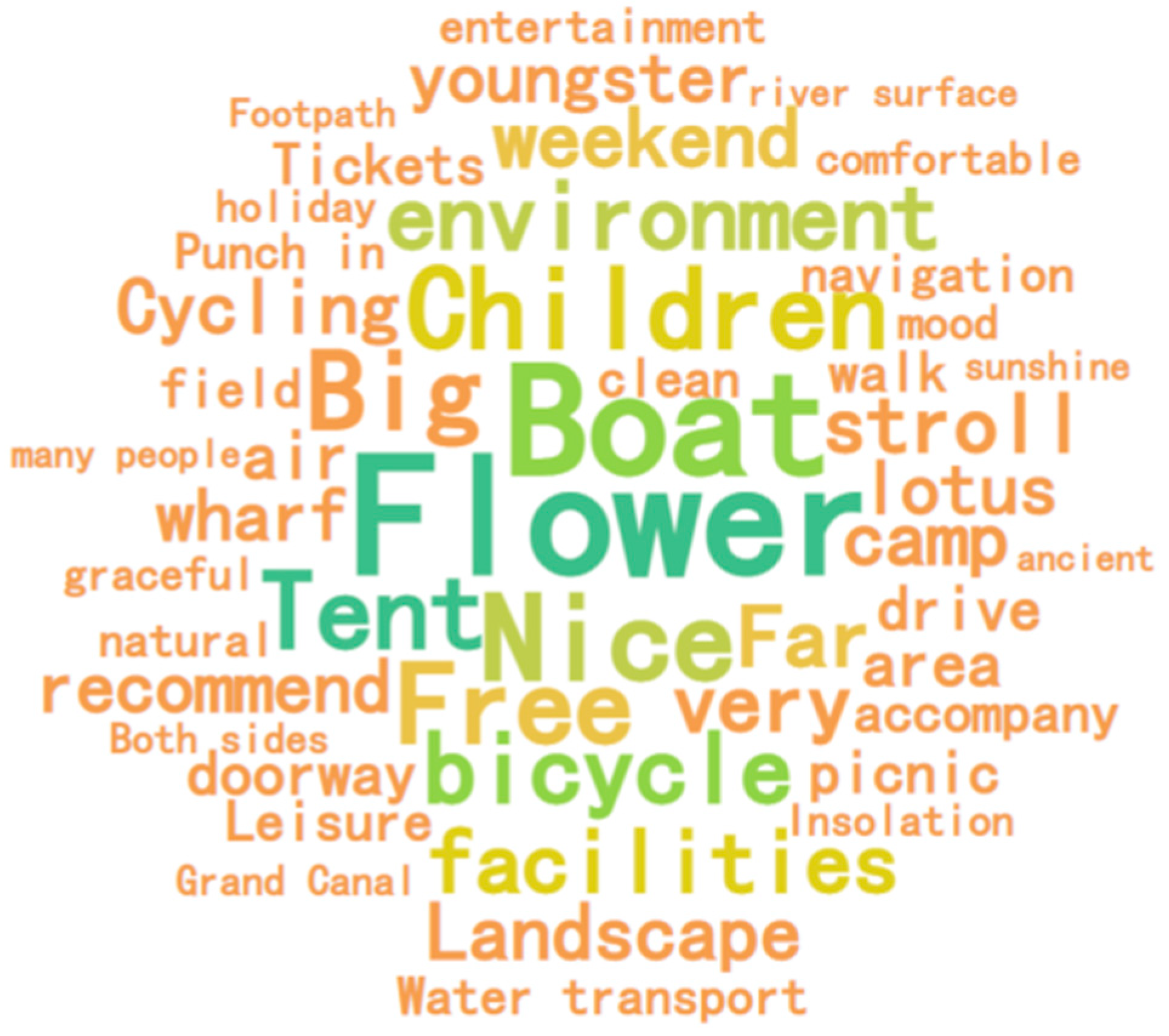
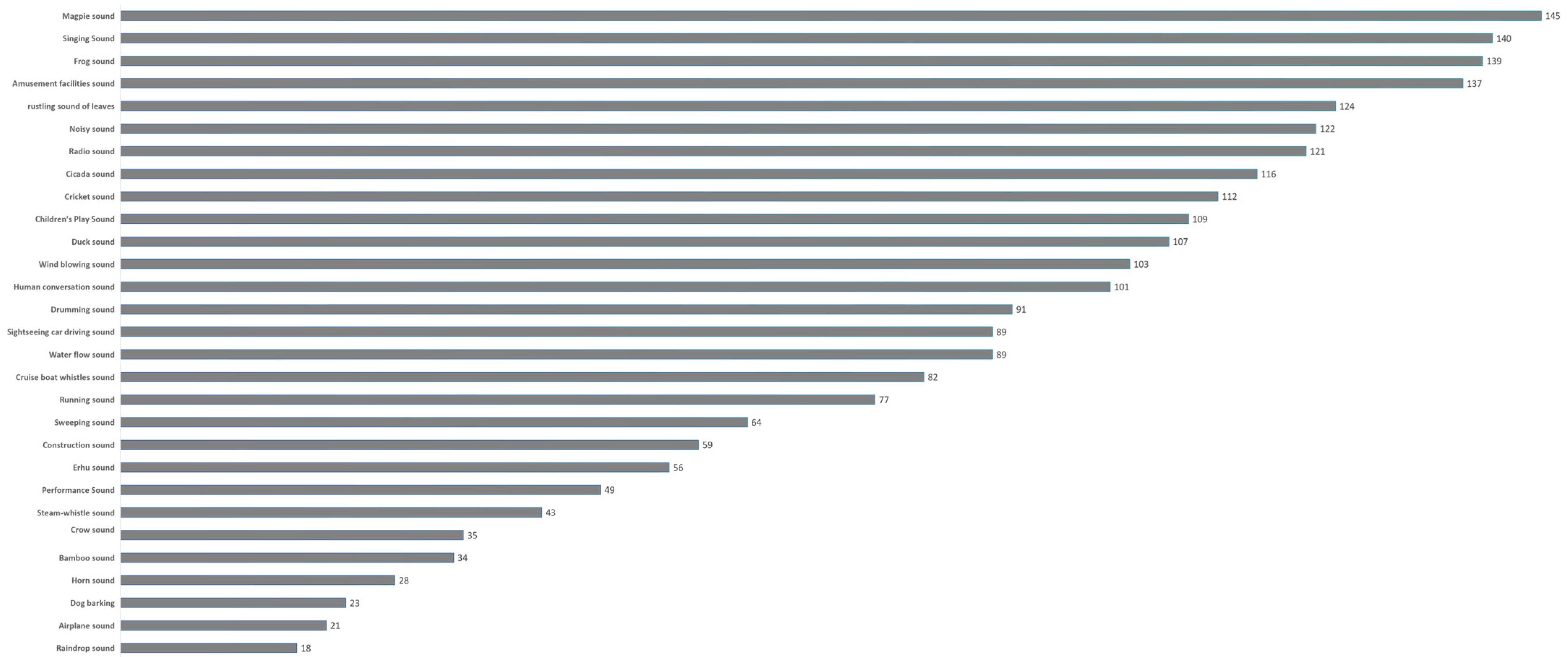
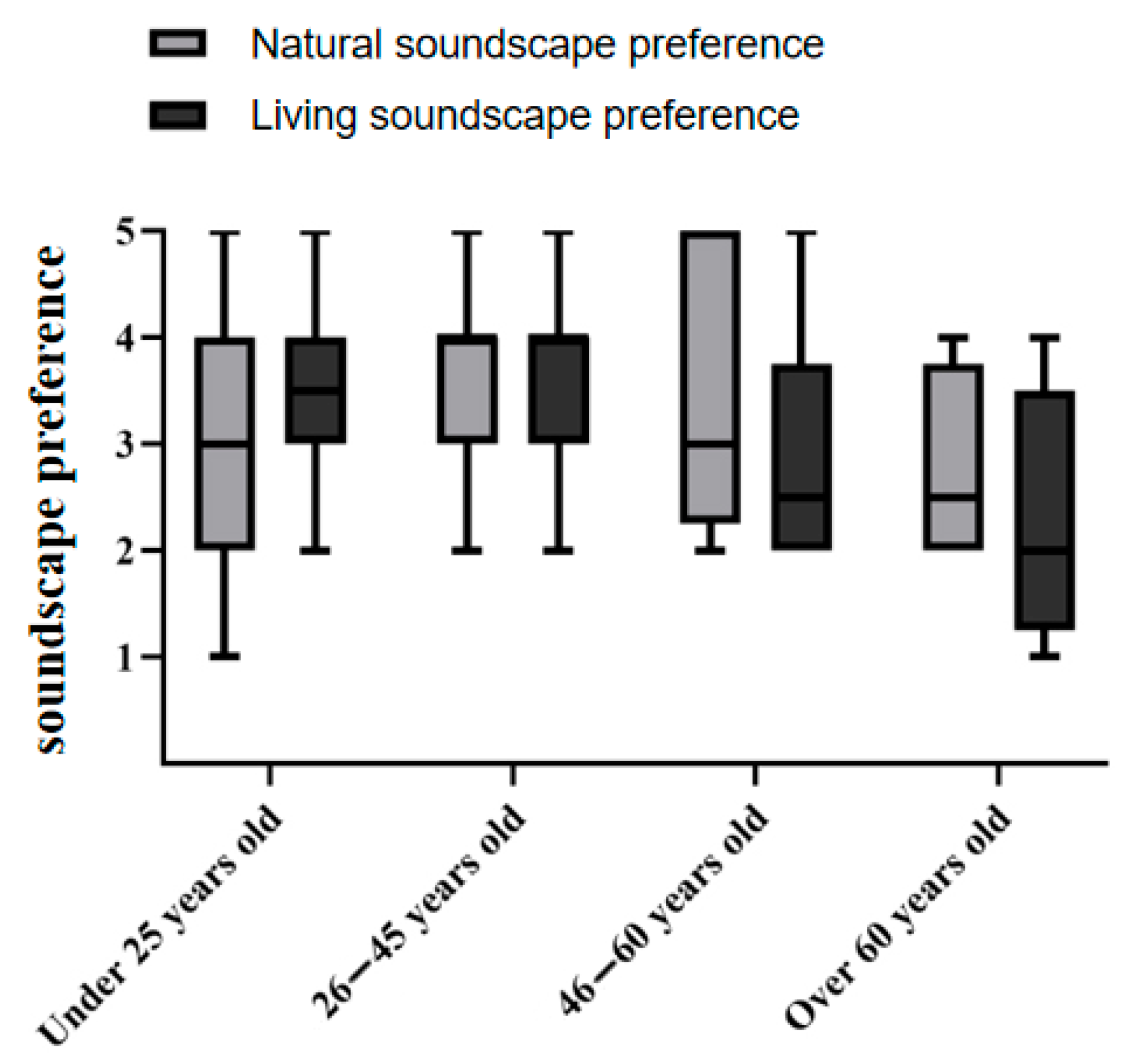

| Word | Frequency | Word | Frequency | Word | Frequency |
|---|---|---|---|---|---|
| Park | 754 | recommend | 245 | entertainment | 109 |
| Flower | 710 | lotus | 243 | mood | 108 |
| Boat | 646 | wharf | 238 | natural | 106 |
| Nice | 476 | youngster | 233 | graceful | 95 |
| Children | 447 | air | 215 | comfortable | 94 |
| Free | 428 | area | 204 | insolation | 87 |
| Big | 424 | drive | 184 | holiday | 86 |
| Tent | 410 | doorway | 182 | Grand Canal | 81 |
| Bicycle | 369 | picnic | 173 | both sides | 79 |
| Environment | 348 | Tickets | 160 | river surface | 72 |
| Facilities | 314 | walk | 156 | sunshine | 67 |
| Far | 302 | leisure | 152 | many people | 66 |
| Very | 293 | accompany | 151 | footpath | 65 |
| Weekend | 291 | field | 139 | ancient | 62 |
| Stroll | 284 | clean | 138 | ||
| Landscape | 269 | water transport | 135 | ||
| Camp | 269 | navigation | 131 | ||
| Cycling | 252 | punch in | 119 |
| Main Soundscape Types | Animal Soundscape | Nature Soundscape | Human Activity Soundscape | Artificial Soundscape | Traffic Soundscape |
|---|---|---|---|---|---|
| Representative sound sources | Cicada sounds Bird sounds Frog sounds Duck sounds | Water Wind Leaves | Children’s sounds Conversation sounds Singing sounds Movement sounds Footsteps Sweeping sounds | Entertainment sounds Radio sounds Instrumental sounds Construction sounds | Boat sounds Traffic sounds Sightseeing car sounds |
| Site 1 | Site 2 | Site 3 | Site 4 |
|---|---|---|---|
| Located to the south of Lutong Bridge in Forest Park, it is mainly landscaped with plants. The overall landscape has a strong historical memory and natural scenery characteristics, and the natural sound is abundant. | The only area in the park surrounded by water on all sides, it features Qiao planting, irrigation, flowers, grass, ground cover, wet and other kinds of plants (more than 100 species. It is the habitat of many birds, and animal sounds and natural sounds are prominent. | There is a pro-level platform built in the area, so that visitors can walk into the deep reed of the Grand Canal, and the sound environment is obviously different from other areas. | With the Grand Canal transport dock as the background, the canal transport culture is displayed. There are special historical and cultural sounds, and artificial and natural sounds are integrated. |
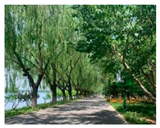 | 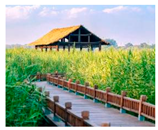 | 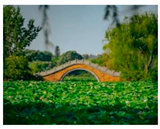 |  |
| Site 1: Luhe Yaoliu scenic spot | Site 2: Yuedao Wenying scenic spot | Site 3: Popular Reed scenic spot | Site 4: Silver Maple Autumn Fruit scenic spot |
| Dimension | Connotative Definition | Code | Description |
|---|---|---|---|
| Leisure and entertainment | The value of leisure and recreational activities provided in the park | LE-1 | Parks can meet the demand for dynamic entertainment activities |
| LE-2 | Parks can meet the demand for static entertainment activities | ||
| Aesthetic experience | The aesthetic perception and viewing value provided by the internal scenery of the park | AE-1 | The water scenery in the park is rich and aesthetically pleasing |
| AE-2 | The night scenery in the park is rich and aesthetically pleasing | ||
| AE-3 | The floral landscape in the park is rich and aesthetically pleasing | ||
| Exercise healing | The value of sports-related relaxation and stress relief provided by the park | EH-1 | Parks can meet the needs of sports and fitness |
| EH-2 | Parks can meet the needs of regulating emotions and releasing stress | ||
| Social relationships | Parks provide opportunities for the public to interact and meet their social needs | SR-1 | Parks can meet the daily needs of parent–child interaction |
| SR-2 | Parks can meet the needs of daily social activities with friends, colleagues, etc. | ||
| Science education | Parks provide the public with opportunities for knowledge dissemination and education | SE-1 | The educational activities that can be carried out on the site are sufficiently diverse |
| SE-2 | There are plenty of volunteer activities available in the park | ||
| History and culture | The cultural and historical value contained in the park | HC | Parks can reflect the historical value and distinctive culture of the canal |
| Heritage protection | The contribution value related to the heritage protection function provided by the park | HP | Parks play a protective role in the cultural heritage of the Grand Canal |
| A sense of place | The value of parks in evoking local memories or attachment among the public | SP | There is a place within the park that can evoke memories or special emotions in you |
| Soundscape Type | Representative Sounds | Frequency Proportion |
|---|---|---|
| Animal soundscape | Cicada sounds | 35.18% |
| Bird sounds | 39.74% max | |
| Frog sounds | 18.24% | |
| Duck sounds | 6.84% | |
| Natural soundscape | Water | 17.14% |
| Wind | 36.19% | |
| Leaves | 46.67% max | |
| Human activity soundscape | Children’s sounds | 25.14% |
| Conversation sounds | 29.43% max | |
| Singing sounds | 7.14% | |
| Movement sounds | 22.57% | |
| Footsteps | 10.29% | |
| Sweeping sounds | 5.43% | |
| Artificial soundscape | Entertainment sounds | 34.52% max |
| Radio sounds | 26.90% | |
| Instrumental sounds | 21.32% | |
| Construction sounds | 17.26% | |
| Traffic soundscape | Cruise boat whistles sounds | 59.66% max |
| Sightseeing car driving sounds | 40.34% |
| Latent Variable | Mean Value | Standard Deviation | F | P | Eta2 |
|---|---|---|---|---|---|
| Animal soundscape preference | 3.65 | 0.83 | 2.076 | 0.108 | 0.061 |
| Natural soundscape preference | 3.60 | 1.02 | 3.115 | 0.030 * | 0.089 |
| human activity soundscape preference | 3.48 | 0.97 | 4.723 | 0.004 ** | 0.129 |
| Traffic soundscape preference | 3.25 | 1.03 | 2.308 | 0.081 | 0.067 |
| Artificial soundscape preference | 3.24 | 1.06 | 1.309 | 0.276 | 0.039 |
| Age Distribution (Mean ± SD) | F | P | ||||
|---|---|---|---|---|---|---|
| Under 25 | Ages 26–45 | 45–60 Years Old | Over 60 Years old | |||
| Natural soundscape preference | 3.26 ± 1.16 | 3.82 ± 0.85 | 3.50 ± 1.31 | 2.75 ± 0.96 | 3.115 | 0.030 * |
| Human activity soundscape preference | 3.37 ± 0.88 | 3.69 ± 0.89 | 2.88 ± 1.13 | 2.25 ± 1.26 | 4.723 | 0.004 ** |
| CES Dimensions | Importance (I) Mean Value | Performance (P) Mean Value |
|---|---|---|
| Leisure and entertainment (LE) | 4.08 | 3.95 |
| Aesthetic experience (AE) | 3.99 | 3.93 |
| Exercise healing (EH) | 3.96 | 3.99 |
| Social relationship (SR) | 3.97 | 3.96 |
| Science education (SE) | 3.99 | 3.88 |
| History and culture (HC) | 4.09 | 3.92 |
| Heritage protection (HP) | 4.04 | 3.85 |
| A sense of place (SP) | 3.90 | 3.97 |
| Total average | 4.00 | 3.93 |
| Variables | Leisure Entertainment | Aesthetic Experience | Exercise Healing | Social Relationships | Science Education | History and Culture | Heritage Protection | A Sense of Place | ||||||
|---|---|---|---|---|---|---|---|---|---|---|---|---|---|---|
| LE-1 | LE-2 | AE-1 | AE-2 | AE-3 | EH-1 | EH-2 | SR-1 | SR-2 | SE-1 | SE-2 | HC | HP | SP | |
| Animal soundscape preference | 0.278 ** | 0.224 * | 0.110 | 0.186 | 0.153 | 0.203 * | 0.282 ** | 0.134 | 0.226 * | 0.051 | 0.086 | 0.264 ** | 0.178 | 0.177 |
| Natural soundscape preference | 0.388 ** | 0.337 ** | 0.205 * | 0.313 ** | 0.306 ** | 0.333 ** | 0.412 ** | 0.322 ** | 0.382 ** | 0.396 ** | 0.316 ** | 0.352 ** | 0.265 ** | 0.248 * |
| Human activity soundscape preference | 0.261 ** | 0.505 ** | 0.287 ** | 0.259 ** | 0.385 ** | 0.287 ** | 0.170 | 0.174 | 0.432 ** | 0.279 ** | 0.275 ** | 0.300 ** | 0.332 ** | 0.472 ** |
| Traffic soundscape preference | 0.243 * | 0.246 * | 0.209 * | 0.220 * | 0.199 * | 0.141 | 0.134 | 0.120 | 0.262 ** | 0.256 * | 0.162 | 0.193 | 0.199 * | 0.312 ** |
| Artificial soundscape preference | 0.246 * | 0.264 ** | 0.174 | 0.264 ** | 0.199 * | 0.105 | 0.176 | 0.147 | 0.177 | 0.237 * | 0.162 | 0.177 | 0.173 | 0.195 |
Disclaimer/Publisher’s Note: The statements, opinions and data contained in all publications are solely those of the individual author(s) and contributor(s) and not of MDPI and/or the editor(s). MDPI and/or the editor(s) disclaim responsibility for any injury to people or property resulting from any ideas, methods, instructions or products referred to in the content. |
© 2025 by the authors. Licensee MDPI, Basel, Switzerland. This article is an open access article distributed under the terms and conditions of the Creative Commons Attribution (CC BY) license (https://creativecommons.org/licenses/by/4.0/).
Share and Cite
Mao, L.; Hou, H.; Xia, Z.; Zhang, X. Soundscape Preferences and Cultural Ecosystem Services in the Grand Canal National Cultural Park: A Case Study of Tongzhou Forest Park. Buildings 2025, 15, 2360. https://doi.org/10.3390/buildings15132360
Mao L, Hou H, Xia Z, Zhang X. Soundscape Preferences and Cultural Ecosystem Services in the Grand Canal National Cultural Park: A Case Study of Tongzhou Forest Park. Buildings. 2025; 15(13):2360. https://doi.org/10.3390/buildings15132360
Chicago/Turabian StyleMao, Linqing, Hongyu Hou, Ziting Xia, and Xin Zhang. 2025. "Soundscape Preferences and Cultural Ecosystem Services in the Grand Canal National Cultural Park: A Case Study of Tongzhou Forest Park" Buildings 15, no. 13: 2360. https://doi.org/10.3390/buildings15132360
APA StyleMao, L., Hou, H., Xia, Z., & Zhang, X. (2025). Soundscape Preferences and Cultural Ecosystem Services in the Grand Canal National Cultural Park: A Case Study of Tongzhou Forest Park. Buildings, 15(13), 2360. https://doi.org/10.3390/buildings15132360






